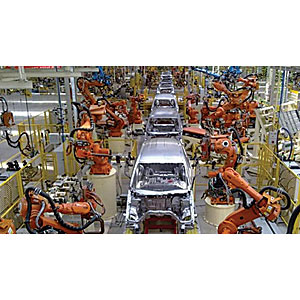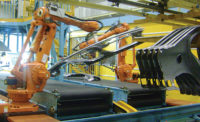
|
|
The new welding line at Great Wall Motors’ state-of-the-art automotive plant in Tianjin, China, comprises 30 workstations and 27 robots. Photo courtesy ABB Robotics.
|
Several vehicle models are made at the plant, which is considered the most technically advanced automotive factory in China. One model is the Haval SUV.
One of the factory’s most highly publicized, and productive, manufacturing lines is the automated welding line. Developed by ABB Robotics, this turnkey welding line gives GWM the flexibility to weld different car models as needed. This flexibility helps GWM stay cost- and deadline-competitive with other automakers in China and worldwide.
The welding line comprises 30 workstations and 27 ABB robots (models IRB 6640 and IRB 7600). ABB also supplied all the welding fixtures and robot grippers, control system and roller bed to transfer the car body.
The robots perform more than 4,000 welding operations on a car body at high levels of accuracy, speed, consistency and shock resistance. These capabilities help GWM maintain high levels of productivity, product quality and vehicle safety. For example, the cycle time for welding an entire Haval SUV is just 86 seconds, including transfer between stations.
The IRB 7600 robots, which can handle material weighing up to 500 kilograms, hold the panels securely and accurately in place while IRB 6640 robots perform the welding.
The IRB 6640 robots are equipped with servo guns, which are designed to weld 25 percent faster than traditional pneumatic guns. Welds produced with the servo guns are 30 percent more shock resistant than common braze welds.
Two other unique technologies on the welding line are ABB’s FlexFramer car body assembly and roller hemming systems. FlexFramer welds the roof, underbody and sides together to create the main frame of the vehicle.
The roller hemming system hems together the outer and inner panels of the doors, hood and deck lid. The system can control the hemming pressure along entire flange length and is less sensitive to flange angle and flange length variations. As a result, it produces consistently high-quality assemblies.
The hemming path can be programmed offline, reducing on-site programming time and trial-out time.
For more information on turnkey automated welding systems, call 248-391-9000 or visit www.abb.com/robotics.

